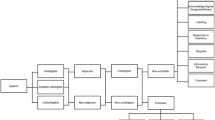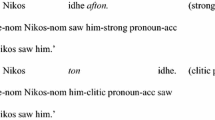Abstract
Audiotaped conversational samples from adults diagnosed as having autistic disorders (n=15) or developmental receptive language disorders (n=17) in childhood were transcribed and analyzed using methods based on those of Bishop and Adams (1989). Subjects with autism showed substantially greater pragmatic impairment not explicable by generalized impairment of verbal skills. This was mainly due to autistic subjects' greater difficulty in forming context-relevant communicative intentions; in contrast, pragmatic impairments arising from failures in translating intentions into spoken utterances (i.e., impairments at the level of execution) did not distinguish between the groups. In both diagnostic groups, impairment in forming appropriate communicative intentions was closely related to more generalized impairment of reciprocal social behavior.
Similar content being viewed by others
References
Baker, L., Cantwell, D. P., Rutter, M., & Bartak, L. (1976). Language and autism. In E. Ritvo (Ed.),Autism: Diagnosis, current research and management. New York: Spectrum.
Baltaxe, C. (1977). Pragmatic deficits in the language of autistic adolescents.Journal of Pediatric Psychology, 2, 176–180.
Baron-Cohen, S. (1988). Social and pragmatic deficits in autism: Cognitive or affective?Journal of Autism and Developmental Disorders, 18, 379–402.
Baron-Cohen, S., Leslie, A. M., & Frith, U. (1985). Does the autistic child have a ‘theory of mind’?Cognition, 21, 37–46.
Bartak, L., Rutter, M., & Cox, A. (1975). A comparative study of infantile autism and specific developmental receptive language disorder. I: The children.British Joural of Psychiatry, 126, 127–145.
Bishop, D. V. M., (1989). Autism, Asperger's syndrome and semantic-pragmatic disorder: Where are the boundaries?British Journal of Disorders of Communication, 24, 107–121.
Bishop, D. V. M., & Adams, C. (1989). Conversational characteristics of children with semantic-pragmatic disorder: II: What features lead to a judgement of inappropriacy?British Journal of Disorders of Communication, 24, 241–263.
Bishop, D. V. M., & Rosenbloom, L. (1987). Childhood language disorders: Classification and overview. In W. Yule & M. Rutter (Eds.),Language development and disorders (pp. 16–41). London: MacKeith.
Cantwell, D., Baker, L., Rutter, M., & Mawhood, L. (1989). Infantile autism and developmental receptive dysphasia: A comparative follow-up into middle childhood.Journal of Autism and Developmental Disorders, 19, 19–32.
Cromer, R. (1981). Developmental language disorders: Cognitive processes, semantics, pragmatics, phonology, and syntax.Journal of Autism and Developmental Disorders, 11, 57–61.
Cunningham, C. E., Siegel, L. S., Van der Spuy, H., & Bow, S. J. (1985). The behavioural and linguistic interactions of specifically language-disordered and normal boys with their mothers.Child Development, 56, 1389–1403.
Fein, D., Pennington, B., Markowitz, P., Braverman, M., & Waterhouse, L. (1986). Towards a neuropsychological model of infantile autism: Are the social deficits primary?Journal of The American Academy of Child and Adolescent Psychiatry, 25, 198–212.
Fey, M. E., & Leonard, L. B. (1983). Pragmatic skills of children with specific language impairment. In T. M. Gallagher & C. A. Prutting (Eds.),Pragmatic assessment and intervention issues in language. San Diego: College-Hill.
Frith, U., Morton, J., & Leslie, A. M. (1991). The cognitive basis of a biological disorder: Autism.Trends in Neurosciences, 14, 433–438.
Goodman, R. (1989). Infantile autism: A syndrome of multiple primary deficits?Journal of Autism and Developmental Disorders, 19, 409–424.
Grice, H. P. (1957). Meaning.Philosophical Review, 66, 377–388.
Grice, H. P. (1975). Logic and conversation. In P. Cole & J. Morgan (Eds.),Syntax and semantics 3: Speech acts. New York: Academic Press.
Grice, H. P. (1978). Further notes on logic and conversation. In P. Cole (Ed.),Syntax and semantics 9: Pragmatics. New York: Academic Press.
Kanner, L. (1946). Irrelevant and metaphorical language in early infantile autism.American Journal of Psychiatry, 103, 242–246.
Kolvin, I., Fundudis, T., George, G. S., Wrate, R. M., & Scarth, L. (1979). Predictive importance—behavior. In T. Fundudis, I. Kolvin, & R. Garside (Eds.),Speech retarded and deaf children: Their psychological development (pp. 67–77). London: Academic Press.
Landry, S. H., & Loveland, K. A. (1988). Communication behaviours in autism and developmental language delay.Journal of Child Psychology and Psychiatry, 29, 621–634.
Levinson, S. C. (1983).Pragmatics. Cambridge, England: Cambridge University Press.
Lord, C., Rutter, M., Goode, S., Heemsbergen, J., Jordan, H., Mawhood, L., & Schopler, E. (1989). Autism diagnostic observation schedule: A standardized observation of communication and social behavior.Journal of Autism and Developmental Disorders, 19, 185–212.
Loveland, K. A., & Tunali, B. (1991). Social scripts for conversational interactions in autism and Down syndrome.Journal of Autism and Developmental Disorders, 21, 177–186.
Paul, R. (1987). Communication. In D. J. Cohen & A. M. Donnellan (Eds.),Handbook of autism and pervasive developmental disorders. New York: Wiley.
Prizant, B. M., & Duchan, J. E. (1981). The functions of immediate echolalia in autistic children.Journal of Speech and Hearing Disorders, 46, 241–249.
Prizant, B. M., & Wetherby, A. M. (1987). Communicative intent: A framework for understandin social-communicative behavior in autism.Journal of the American Academy of Child and Adolescent Psychiatry, 26, 472–479.
Prutting, C. A., & Kirchner, D. M. (1987). A clinical appraisal of the pragmatic aspects of language.Journal of Speech and Hearing Disorders, 52, 105–119.
Rapin, I., & Allen, D. A. (1983). Developmental language disorders: Nosologic considerations. In U. Kirk (Ed.),Neuropsychology of language, reading and spelling (pp. 155–184). New York: Academic Press.
Rapin, I. & Allen, D. A. (1987). Developmental dysphasia and autism in preschool children: Characteristics and subtypes. InProceedings of the 1st International Symposium on Specific Speech and Language Disorders in Children. London: AFASIC.
Rochester, S. R., Martin, J. R., & Thurston, S. (1977). Thought-process disorder in schizophrenia: The listener's task.Brain and Language, 4, 95–114.
Rutter, M. (1968). Concepts of autism: A review of research.Journal of Child Psychology and Psychiatry, 9, 1–25.
Rutter, M. (1978). Diagnosis and definition. In M. Rutter & E. Schopler (Eds.),Autism: A reappraisal of concepts and treatment. New York: Plenum Press.
Rutter, M. (1983). Cognitive deficits in the pathogenesis of autism.Journal of Child Psychology and Psychiatry, 24, 513–531.
Rutter, M., Mawhood, L., & Howlin, P. (1992).Language delay and social development. Paper presented at 2nd International Symposium on Specific Speech and Language Disorders in Children, Harrogate, England.
Schiffer, S. R. (1972).Meaning. Oxford: Clarendon.
Siegel, L. S., Cunningham, C. E., & Van der Spuy, H. (1985). Interactions of language-delayed and normal preschool boys with their peers.Journal of Child Psychology and Psychiatry, 26, 77–83.
Sperber, D., & Wilson, D. (1986).Relevance: Communication and cognition. Oxford: Blackwell.
Strawson, P. (1964). Intention and convention in speech acts.Philosophical Review, 73, 439–460.
Swisher, L., & Demetras, M. J., (1985). The expressive language characteristics of autistic children compared with mentally retarded or specific language-impaired children. In E. Schopler & G. Mesibov (Eds.),Communication problems in autism. New York: Plenum Press.
Swisher, L. P., & Pinsker, E. J. (1971). The language characteristics of hyperverbal hydrocephalic children.Developmental Medicine and Child Neurology, 13, 746–755.
Tager-Flusberg, H. (1981). On the nature of linguistic functioning in autism.Journal of Autism and Developmental Disorders, 11, 45–56.
Tager-Flusberg, H. (1989). A psycholinguistic perspective on language development in the autistic child. In G. Dawson (Ed.), Autism: Nature, diagnosis and treatment. New York: Guilford.
Tager-Flusberg, H., Calkins, S., Nolin, T., Baumberger, T., Anderson, M., & Chadwick-Dias, A. (1990). A longitudinal study of language acquisition in autistic and Down syndrome children.Journal of Autism and Developmental Disorders, 20, 1–22.
van der Gaag, A. D. (1989). The view from Walter's window: Social environment and the communicative competence of adults with a mental handicap.Journal of Mental Deficiency Research, 33, 221–227.
Volden, J., & Lord, C. (1991). Neologisms and idiosyncratic language in autistic speakers.Journal of Autism and Developmental Disorders, 21, 109–130.
Wetherby, A. M. (1986). Ontogeny of communication functions in autism.Journal of Autism and Developmental Disorders, 16, 295–316.
Author information
Authors and Affiliations
Additional information
The author was supported by the Bethlem Royal and Maudsley Hospital Research Fund. Lynn Mawhood very kindly provided all of the primary data and extracted the conversational samples from her recorded interviews. I also thank Dorothy Bishop, Mary Crowson, Helen Eales, and Professor Sir Michael Rutter for advice and help in various aspects of the study.
Rights and permissions
About this article
Cite this article
Eales, M.J. Pragmatic impairments in adults with childhood diagnoses of autism or developmental receptive language disorder. J Autism Dev Disord 23, 593–617 (1993). https://doi.org/10.1007/BF01046104
Issue Date:
DOI: https://doi.org/10.1007/BF01046104




